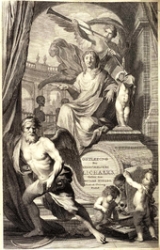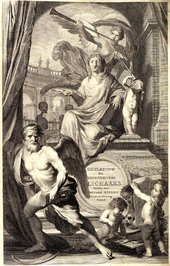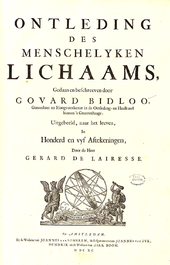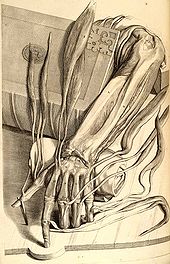
Govert Bidloo
Encyclopedia
Govert Bidloo or Govard Bidloo (Amsterdam
, 12 March 1649 - Leiden, 30 March 1713) was a Dutch Golden Age
physician, anatomist, poet and playwright. He was the personal physician of William III of Orange-Nassau
, Dutch stadholder and king of England.
Bidloo was also a prolific and popular poet, opera librettist, and playwright. He wrote the libretto for the first-ever Dutch opera, Ceres, Venus en Bacchus (1686) by Johan Schenck. His collected works were published in three volumes after his death.
. He then studied medicine at the University of Franeker
, receiving his degree in 1682. In 1688 he became a lecturer of anatomical dissection in The Hague
, and in 1690 he was appointed head of the national hospital service, a post he also held in England
from 1692. In 1694 he became a professor of anatomy and medicine at the University of Leiden
, a position he held until his death in 1713, when he was succeeded by Herman Boerhaave
.
In 1685 he published an anatomical atlas, Anatomia Humani Corporis . The atlas was illustrated with 105 plates by Gerard de Lairesse
, showing the human figure both in living attitudes and as dissected cadavers. The book was later plagiarized by English surgeon William Cowper
for his Anatomy of the Humane Bodies (1698), which gave no credit to either Bidloo or de Lairesse. This led to a number of vitriolic exchanges between Bidloo and Cowper, including several pamphlets published in each anatomist's defense.
William III
, Dutch stadholder and king of England, asked Bidloo to become his personal physician in 1695. The king died in his arms on 8 March 1702.
He was elected a Fellow of the Royal Society of London in 1696.
One of Bidloo's students was his nephew Nicolaas Bidloo
, who would go on to become the personal physician of Russian czar Peter the Great, and also founded a medical school in Moscow
.
Amsterdam
Amsterdam is the largest city and the capital of the Netherlands. The current position of Amsterdam as capital city of the Kingdom of the Netherlands is governed by the constitution of August 24, 1815 and its successors. Amsterdam has a population of 783,364 within city limits, an urban population...
, 12 March 1649 - Leiden, 30 March 1713) was a Dutch Golden Age
Dutch Golden Age
The Golden Age was a period in Dutch history, roughly spanning the 17th century, in which Dutch trade, science, military and art were among the most acclaimed in the world. The first half is characterised by the Eighty Years' War till 1648...
physician, anatomist, poet and playwright. He was the personal physician of William III of Orange-Nassau
William III of England
William III & II was a sovereign Prince of Orange of the House of Orange-Nassau by birth. From 1672 he governed as Stadtholder William III of Orange over Holland, Zeeland, Utrecht, Guelders, and Overijssel of the Dutch Republic. From 1689 he reigned as William III over England and Ireland...
, Dutch stadholder and king of England.
Bidloo was also a prolific and popular poet, opera librettist, and playwright. He wrote the libretto for the first-ever Dutch opera, Ceres, Venus en Bacchus (1686) by Johan Schenck. His collected works were published in three volumes after his death.
Life and career
The son of an Amsterdam pharmacist, Bidloo first studied surgery and in 1670 became a student of the anatomist Frederik RuyschFrederik Ruysch
Frederik Ruysch was a Dutch botanist and anatomist, remembered for his developments in anatomical preservation and the creation of dioramas or scenes incorporating human parts...
. He then studied medicine at the University of Franeker
University of Franeker
The University of Franeker was a university in Franeker, Friesland, presently part of the Netherlands. It was the second oldest university of the Netherlands, founded shortly after Leiden University....
, receiving his degree in 1682. In 1688 he became a lecturer of anatomical dissection in The Hague
The Hague
The Hague is the capital city of the province of South Holland in the Netherlands. With a population of 500,000 inhabitants , it is the third largest city of the Netherlands, after Amsterdam and Rotterdam...
, and in 1690 he was appointed head of the national hospital service, a post he also held in England
England
England is a country that is part of the United Kingdom. It shares land borders with Scotland to the north and Wales to the west; the Irish Sea is to the north west, the Celtic Sea to the south west, with the North Sea to the east and the English Channel to the south separating it from continental...
from 1692. In 1694 he became a professor of anatomy and medicine at the University of Leiden
Leiden University
Leiden University , located in the city of Leiden, is the oldest university in the Netherlands. The university was founded in 1575 by William, Prince of Orange, leader of the Dutch Revolt in the Eighty Years' War. The royal Dutch House of Orange-Nassau and Leiden University still have a close...
, a position he held until his death in 1713, when he was succeeded by Herman Boerhaave
Herman Boerhaave
Herman Boerhaave was a Dutch botanist, humanist and physician of European fame. He is regarded as the founder of clinical teaching and of the modern academic hospital. His main achievement was to demonstrate the relation of symptoms to lesions...
.
In 1685 he published an anatomical atlas, Anatomia Humani Corporis . The atlas was illustrated with 105 plates by Gerard de Lairesse
Gerard de Lairesse
Gerard or Gérard de Lairesse was a Dutch Golden Age painter and art theorist.Lairesse was born in Liège. His broad range of talent included music, poetry, and the theatre. He was perhaps the most celebrated Dutch painter in the period following the death of Rembrandt...
, showing the human figure both in living attitudes and as dissected cadavers. The book was later plagiarized by English surgeon William Cowper
William Cowper (anatomist)
William Cowper FRS was an English surgeon and anatomist, famous for his early description of what is now known as the Cowper's gland....
for his Anatomy of the Humane Bodies (1698), which gave no credit to either Bidloo or de Lairesse. This led to a number of vitriolic exchanges between Bidloo and Cowper, including several pamphlets published in each anatomist's defense.
William III
William III of England
William III & II was a sovereign Prince of Orange of the House of Orange-Nassau by birth. From 1672 he governed as Stadtholder William III of Orange over Holland, Zeeland, Utrecht, Guelders, and Overijssel of the Dutch Republic. From 1689 he reigned as William III over England and Ireland...
, Dutch stadholder and king of England, asked Bidloo to become his personal physician in 1695. The king died in his arms on 8 March 1702.
He was elected a Fellow of the Royal Society of London in 1696.
One of Bidloo's students was his nephew Nicolaas Bidloo
Nicolaas Bidloo
Nicolaas Bidloo was a Dutch physician who served as the personal physician of Tsar Peter I of Russia . Bidloo was the director of the first hospital in Russia as well as the first medical school in Russia, and is considered one of the founders of Russian medicine.- Early years :Bidloo came from a...
, who would go on to become the personal physician of Russian czar Peter the Great, and also founded a medical school in Moscow
Moscow
Moscow is the capital, the most populous city, and the most populous federal subject of Russia. The city is a major political, economic, cultural, scientific, religious, financial, educational, and transportation centre of Russia and the continent...
.
 |
 |
 |
External links
- US National Institutes of Health: Historical Anatomies on the Web Govert Bidloo's Anatomia Humani Corporis (Ontleding des menschelyken lichaams)

